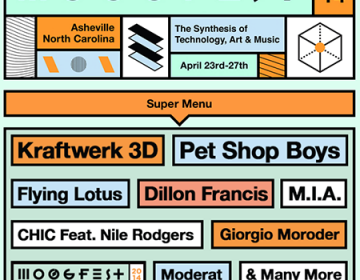The Four Finalists of the Moogfest Circuit Bending Challenge

Now in its 4th year, Moogfest presents the Circuit Bending Challenge, which invites engineers to hack everyday objects to create new instruments. Sponsored by MAKE Magazine, the contest has whittled down to four finalists, whose inventions have been selected by a panel of judges, including Mark Frauenfelder (MAKE Magazine), Ryan Germick (Google), Amos Gaynes (Moog Music), and Andy Huges (Moog Music). The winner will be chosen on Friday April 25th during Moogfest.
Check out the finalists below — each video demonstrates the hacks the engineers used for the challenge, ranging from toy keyboards to scrap wood and barbecue grills.
Stephen Barnwell
The primary motivation for and function of the Cataritone is video synthesis. The goal was to create a module that could take audio and control signals from an analog synthesizer and use them in a consistent and predictable fashion to add a unique visual element to a musical performance.
Mike Sisk
This device is built from a toy Kawasaki/Remco electric guitar, a toy voice changer, a kid’s cassette player, and a PT2399 delay kit. The case was built from a recycled BBQ grill kit, sheet metal from old audio equipment and some scrape wood.
George Gleixner
The device is a Hing Hon EK-001, a small Chinese-built children’s keyboard based on squarewave synthesis. It has been converted into an upright synth with wooden side panels, and a large plexiglass control panel containing a series of bends including distortions, glitches, various modulations, three additional LFOs, optic theremins, video inputs/outputs and more.
C. Freddi
The artist has employed the exquisite sequencing and synthesis capabilities of the Yamaha QY-10to convert any sound source into a state-of-the-art glitch collage via the easy-to-use circuit bending interface mounted on the anterior of the helmet’s crest.






